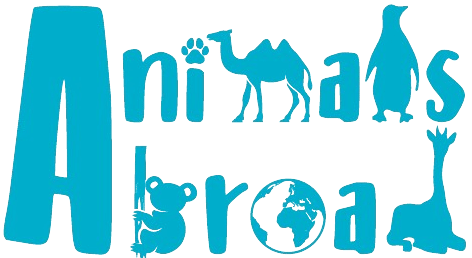Our 51-day adventure across South Africa, Namibia, Botswana, and Zambia was an unforgettable journey that brought us closer as a family and deepened our love for Africa’s wild landscapes. With our two boys in tow, we set off on a self-driving safari, camping under the stars and exploring some of the world’s most iconic national parks.
In Part 3 of our Africa Safari we explored the majestic Victoria Falls and Botswana’s rugged beauty and wildlife. Our detailed itinerary will give you ideas for your trip and make it easier for you to experience the magic of Africa firsthand.
For more practical tips on embarking on your first safari, check out our posts: Camping Safari in Africa: Know Before You Go, Navigating Boarder Crossings in Southern Africa, and Safari with Kids: Tips from the Road.
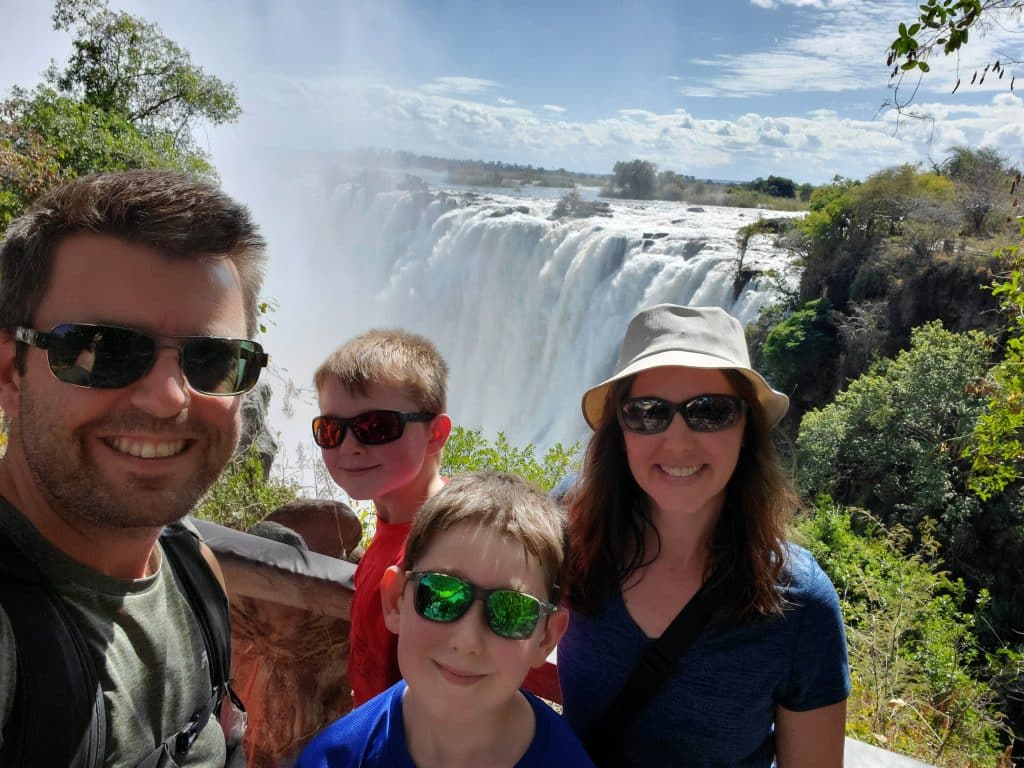
Read about our time along the coasts of Part 1: South Africa & Namibia’s Coast and Part 2: Etosha National Park & the Caprivi Strip
Zambia
Zambia is best known for the awe-inspiring Victoria Falls, one of the world’s seven natural wonders. Our time here was centered around exploring this majestic landmark from the Zambian side, where the falls are just as spectacular but less crowded than on the Zimbabwean side.
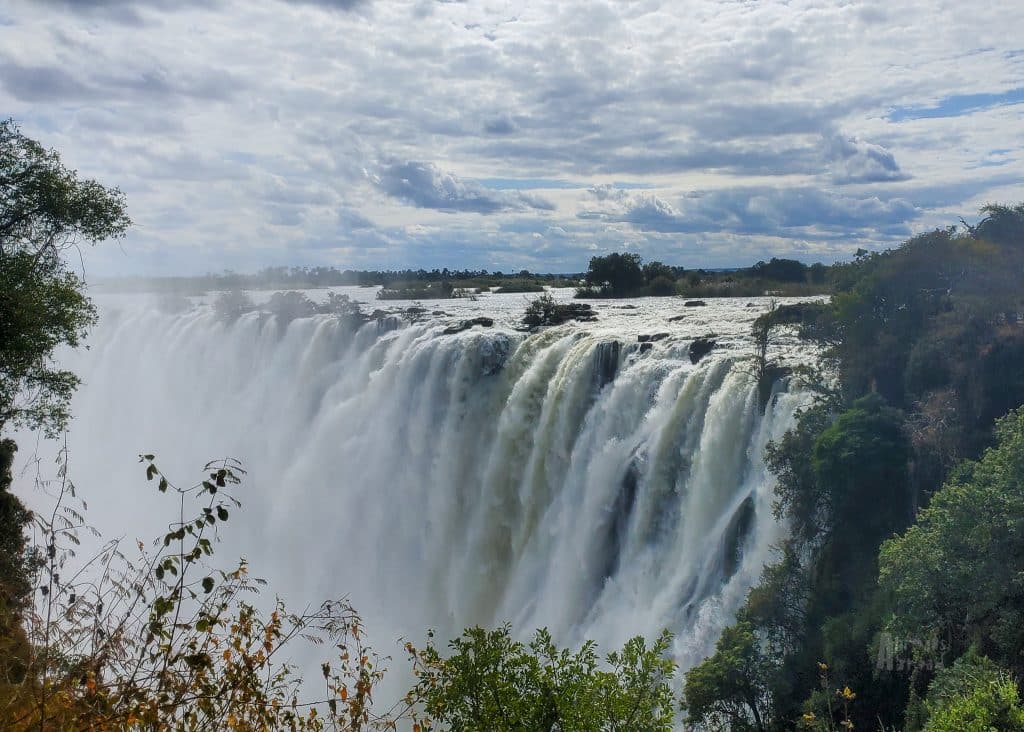
In addition to Victoria Falls, Zambia is renowned for its pristine wilderness and diverse wildlife. While we only spent a short time here, the peaceful atmosphere and proximity to Zambia’s top national parks like South Luangwa and Lower Zambezi left us wanting to return. Zambia’s untouched landscapes, fewer tourists, and commitment to sustainable tourism offer a truly authentic African adventure.
Day 30: Katima Mulilo to Livingstone, Zambia
Border days quickly became our least favourite part of the trip. Each border crossing has its own set of rules, processes, and piles of paperwork. We were grateful we had spent much of the previous day resting, as today was one of our longest travel days.
For more tips on crossing borders, check out: Navigating Border Crossings in Southern Africa.
Entering Zambia meant a drastic change in road conditions. Although Namibia had many bumpy corrugated roads, they were in far better condition. During our first safari in Zambia (in 2007), the tour Derek and I were on was stranded on the side of the road for the better part of a day after the pavement was completely washed away.
We had been warned about the road conditions from the border to Livingstone, but nothing could have prepared us for how bad it really was. “Large potholes,” as many blogs described, didn’t do justice to what we encountered. Chunks of road were missing, and in some places, there seemed to be no road at all. Driving felt like a game of whack-a-mole, constantly swerving to avoid giant holes, some of which spanned 6-10 feet in diameter and were 3 feet deep. I couldn’t imagine navigating this road during the rainy season when it would be flooded, and drivers wouldn’t be able to gauge the depth or size of the trenches ahead.
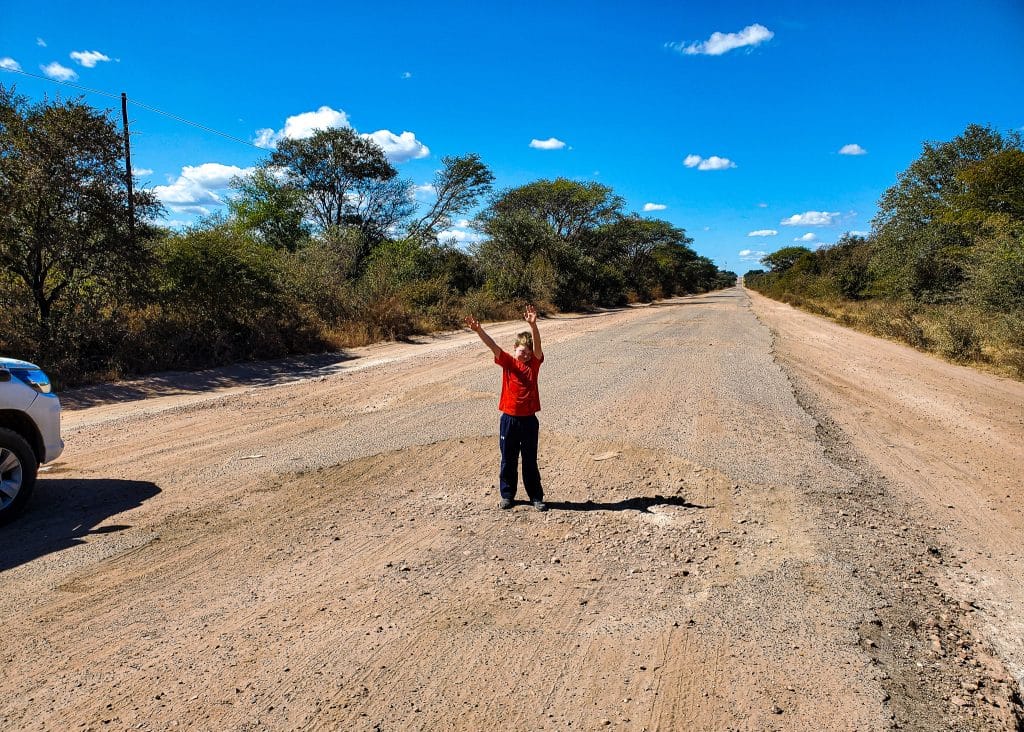
Soft sand and tire tracks covered the shoulder, where many vehicles opted to drive to avoid the worst of the potholes. We spent most of the drive on the shoulder, creeping along at a max speed of 30 km/h for over five and a half nail-biting hours. If you suffer from motion sickness, make sure to take something before you set out. Our kids, who typically have no issues in cars, felt queasy.
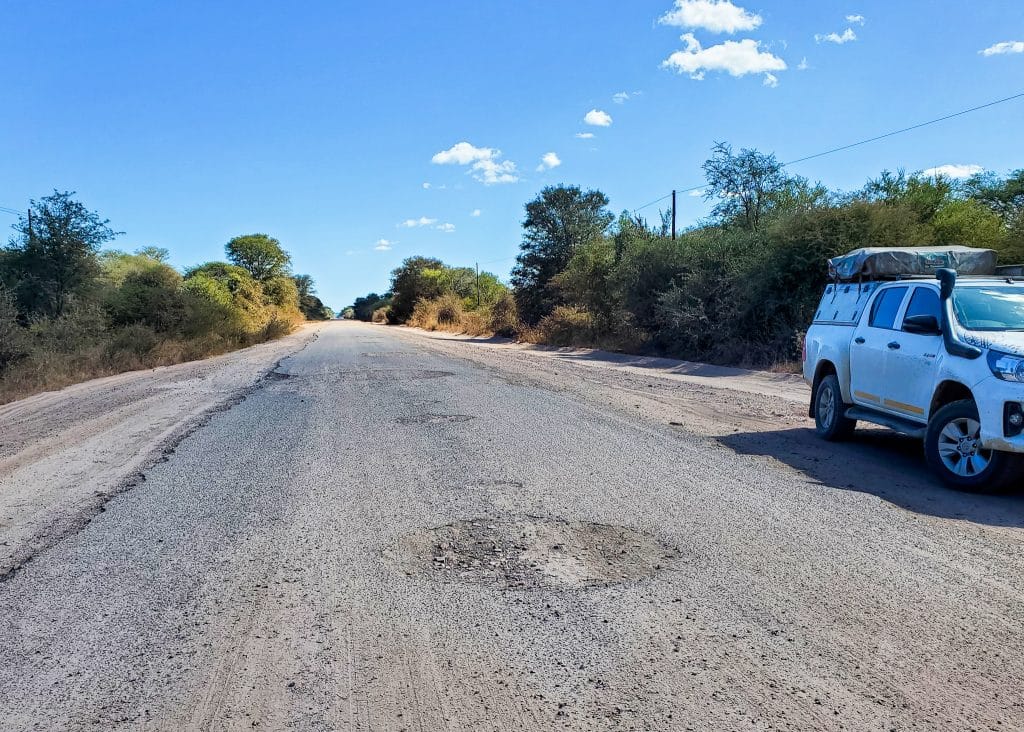
Driving Time: 15 minutes from Caprivi Houseboat Safari Lodge to the Zambian border, then 5 hours and 30 minutes to Livingstone (175km).
Roads: See above.
Campground: Camp Nkwazi
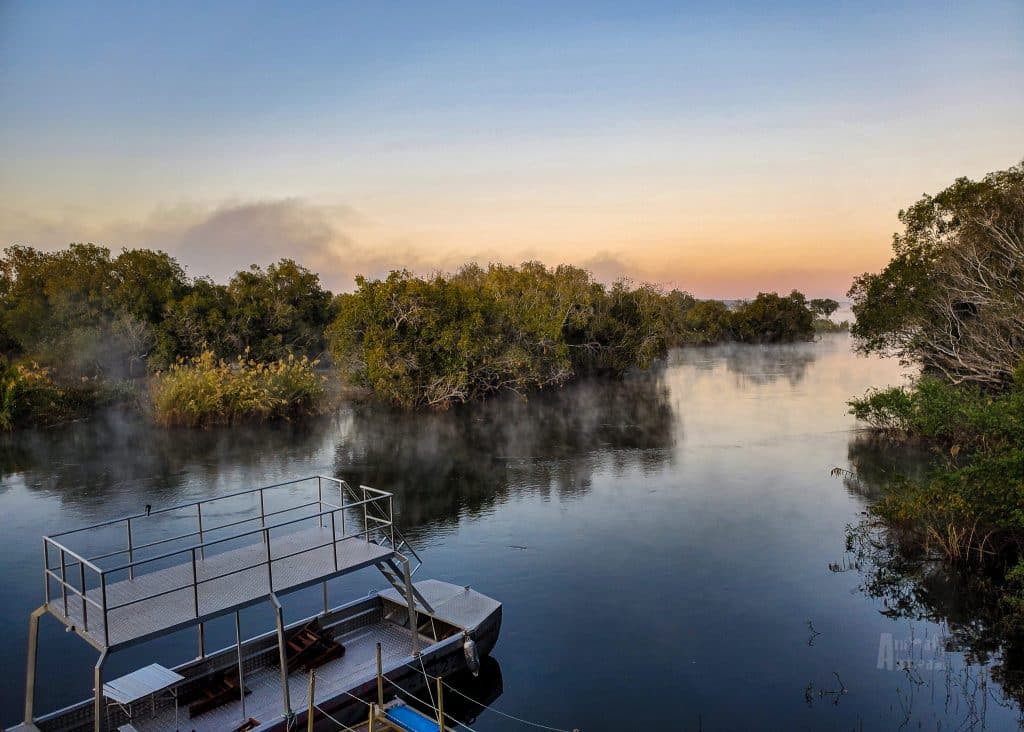
The campsites at Camp Nkwazi were spacious, with three sites sharing one large ablution facility. While we had the campsite to ourselves, it could feel crowded during peak season, as there was little privacy between the sites. The shower was one of the best we experienced on the trip, with steaming hot water on demand and excellent pressure. Each site was equipped with power, lights, a fire pit, and a wash sink. For those looking to relax, there was a pool with lawn chairs. Wi-Fi was available at reception, but the signal reached the campsite intermittently. The campground was fully fenced, ensuring no risk of hippos entering at night.
Day 31: Victoria Falls
Victoria Falls is one of the largest waterfalls in the world and the main attraction in Livingstone. Situated on the Zambezi River, the falls separate Zambia and Zimbabwe, offering viewpoints from both countries.
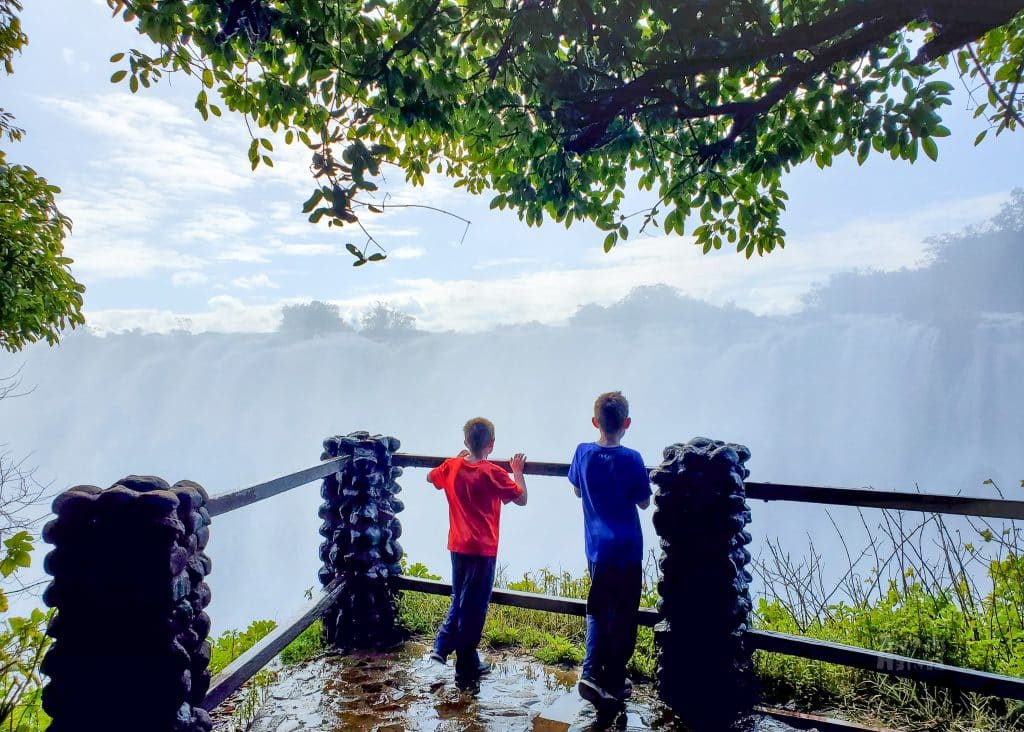
Known as “The Smoke that Thunders,” the sheer power of the water crashing over the falls creates a mist that rises like fog above the viewing platforms. Be prepared to get wet!
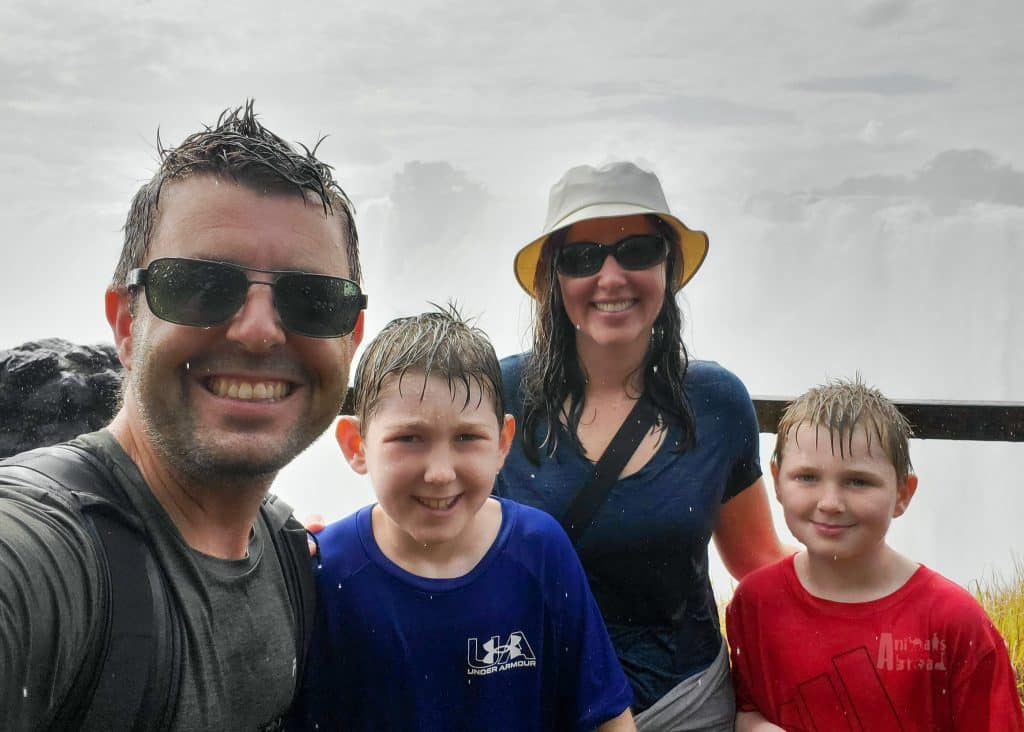
Day 32: Hippo watching – Camp Nkwazi
A small wooden bridge over a pond, nestled among lush vegetation, connects the Nkwazi campsites to the open-air bar and restaurant. You can enjoy stunning views of the Zambezi River from the patio, where hippos are often seen and heard lounging on the beach across the way.
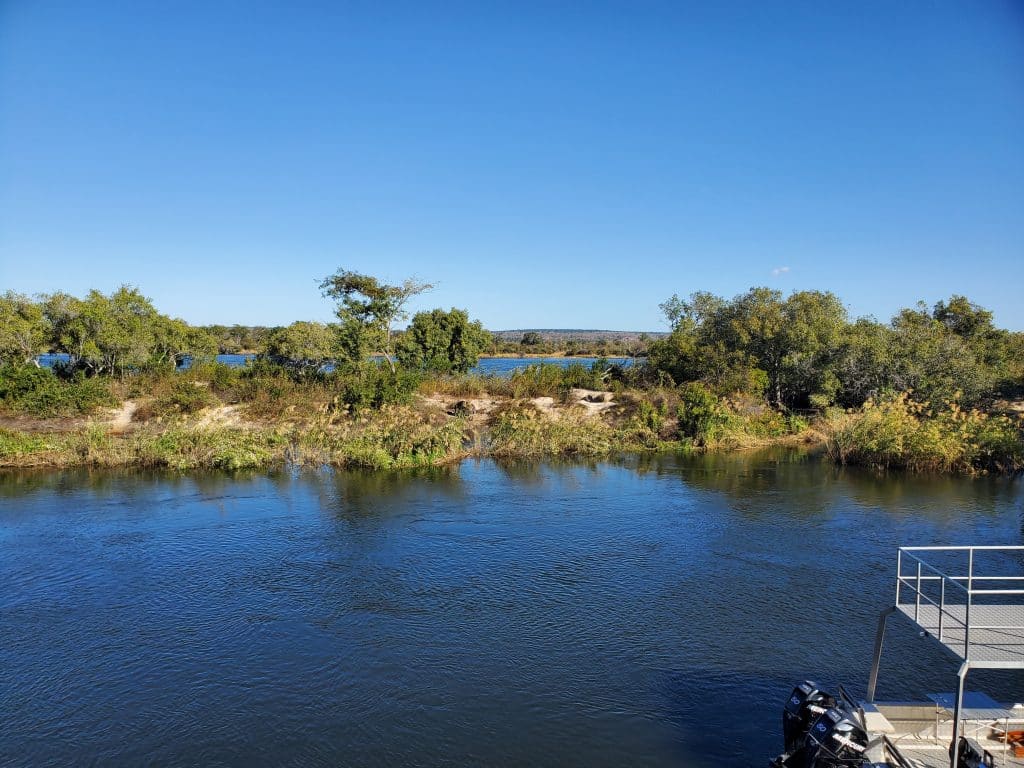
We spent the day watching the hippos, playing cards, and catching up on schoolwork. In the evening, we treated ourselves to pizza at the restaurant.
Botswana
Home to the famous Okavango Delta and Makgadikgadi Salt Pans, Botswana offers an incredibly diverse ecosystem experience. For animal lovers, Chobe National Park is one of the best places for wildlife viewing.
Along our journey, we ran into a local who said, “When camping in South Africa and Namibia, you camp next to animals, while in Botswana, you camp among them.” This was exactly our experience.
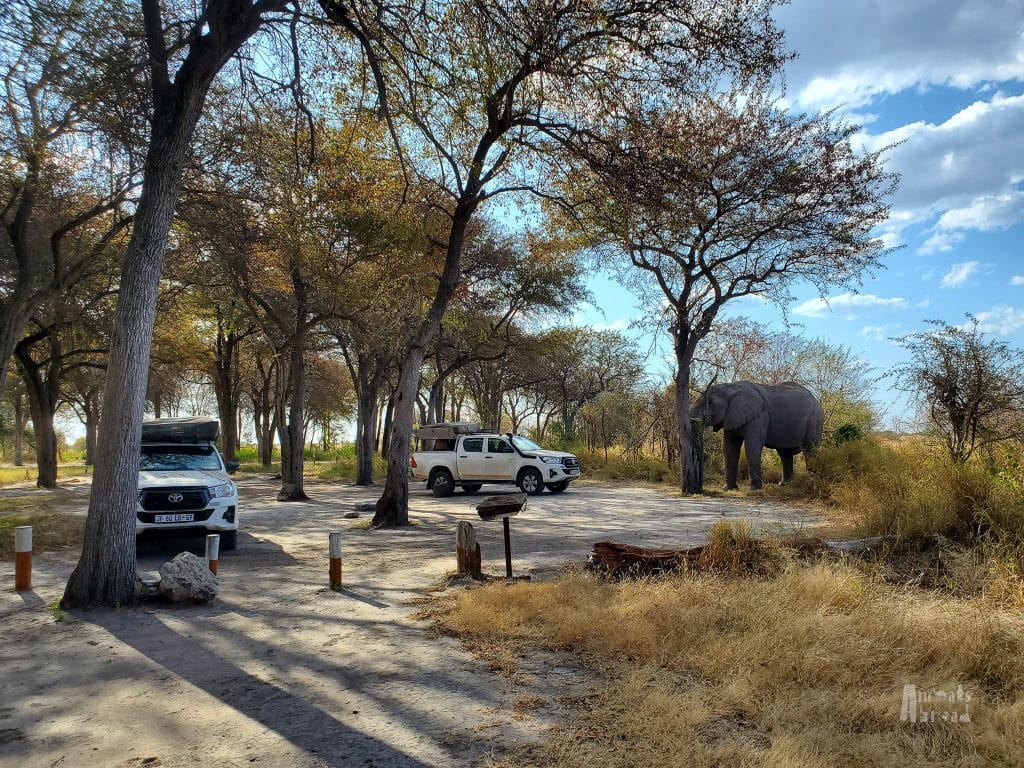
Botswana’s National Parks have intentionally remained rural. This allows for some of Africa’s best viewing opportunities because the animals roam free. As such, there is always the possibility of animals wandering into the campgrounds to join you. We saw many animals in and around our campsite and even more pawprints when we climbed down from our tents in the mornings.
In addition, Botswana is far more expensive than South Africa and Namibia. The people of Botswana value their resources and want to preserve them for years to come. The higher prices limit the number of tourists, decreasing the impact of human-wildlife contact and preventing crowds from destroying the habitats.
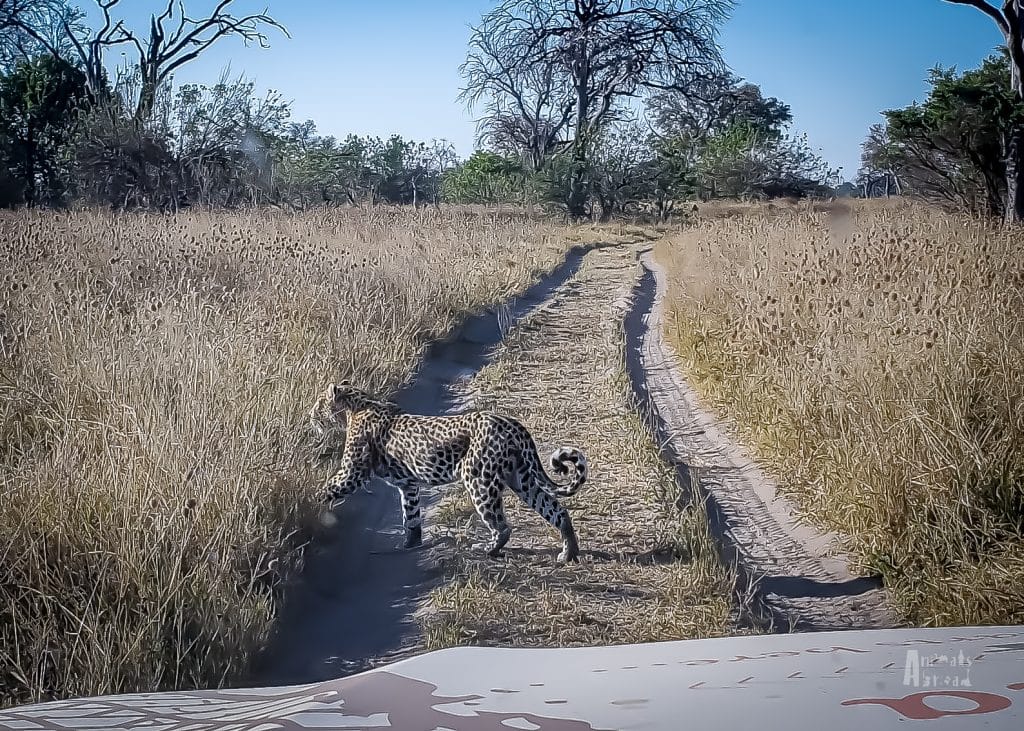
You’re in good company if you’re looking for more comfortable settings. Known for some famous visitors, such as the royal family of England, Botswana is where luxury meets wilderness. There were incredible lodgings, many over USD 500 per person per night. Fortunately, there is a range of accommodation with more affordable prices.
Day 33: Livingstone to Kasane, Botswana
Excited about everything Botswana had to offer, we crossed the border and headed to Kasane, a bustling town near the border. After grabbing some supplies, we made our way to Chobe Safari Lodge, just minutes from Chobe National Park.
Learn More: Navigating Boarder Crossings in Southern Africa
The main attraction of the campsite was the Lodge, located only a short walk from the camping area. Perched on the edge of the Zambezi River, the Lodge features an open-air restaurant and patio, along with a large pool and lounge chairs perfect for a relaxing afternoon while soaking in the views.
Driving Time: 2 hours and 30 minutes (not including border time)
Roads: Paved highway.
Supplies: Chobe Safari Lodge is located off the main road in Kasane. Several grocery stores were located between the border and the campground to stop for supplies.
Campground: Chobe Safari Lodge
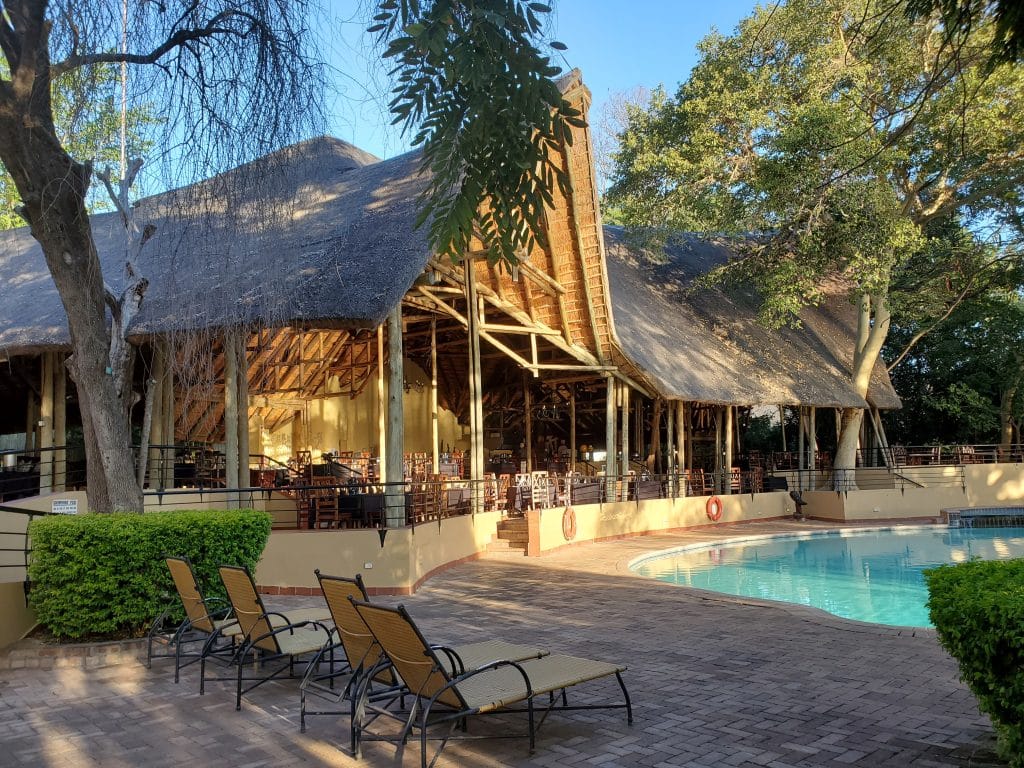
The campsites at the Chobe Safari Lodge were small and packed closely together, with limited privacy. There was no water on-site, but communal sinks were available for cooking water and dishwashing. Each site was equipped with power and lights, with electric plugs available for charging devices. Wi-Fi was accessible at reception. Chobe National Park is just a few minutes away, and the Lodge offered a variety of wildlife experiences, including land, boat, and helicopter tours. Self-drive, guided, and private safari options were available.
Day 34: Chobe River Front (Kasane)
We spent the day poolside at Chobe Safari Lodge, then booked the most popular tour—the sunset cruise along the Chobe River. The water-based safari offered incredible opportunities for close-up encounters with hippos, crocodiles, and waterfowl. If you’re lucky, you might even spot playful elephants taking a bath.
Learn More: Sunset Cruise on the Chobe River: A Photo Journey
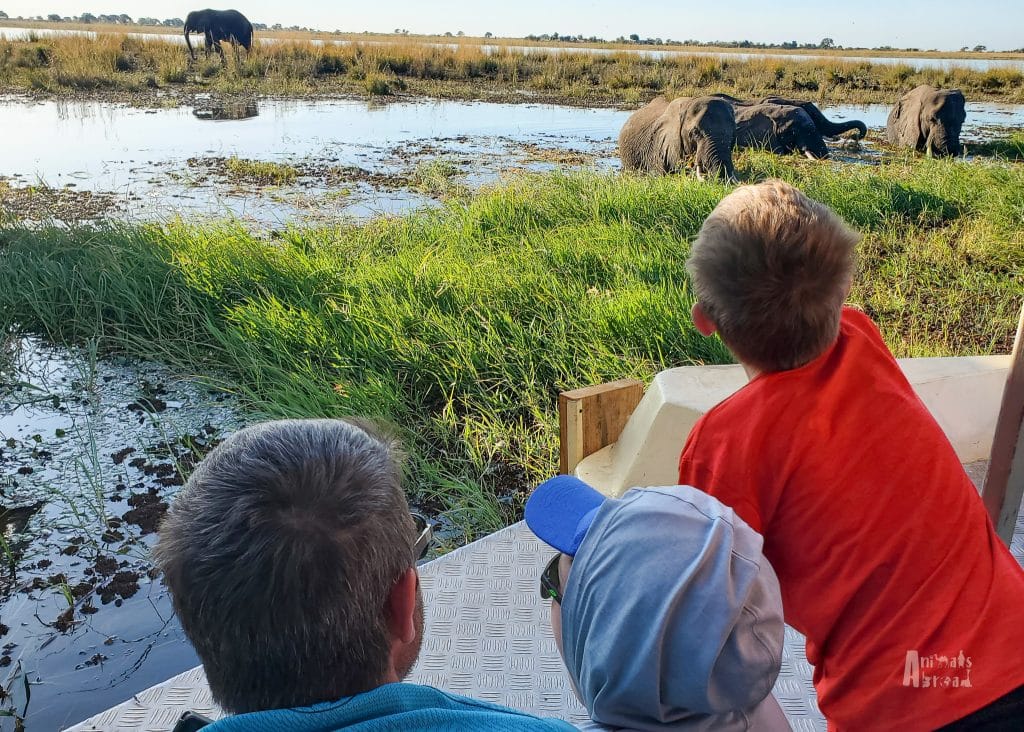
Day 35 & 36: Linyanti, Chobe National Park
Our drive to Linyanti marked our first venture off the main roads in Botswana. Many travellers we’d met over the past couple of weeks had already journeyed through Botswana, and the consensus was clear—while Botswana offers spectacular game viewing, it is rugged, wild, and challenging to navigate. We certainly found this to be true.
With a woodland landscape, Linyanti features lush floodplains and lagoons. It’s home to a large concentration of lions, leopards, and wild dogs. The area is also famous for its massive elephant population, which migrates along the Linyanti River during the dry season.
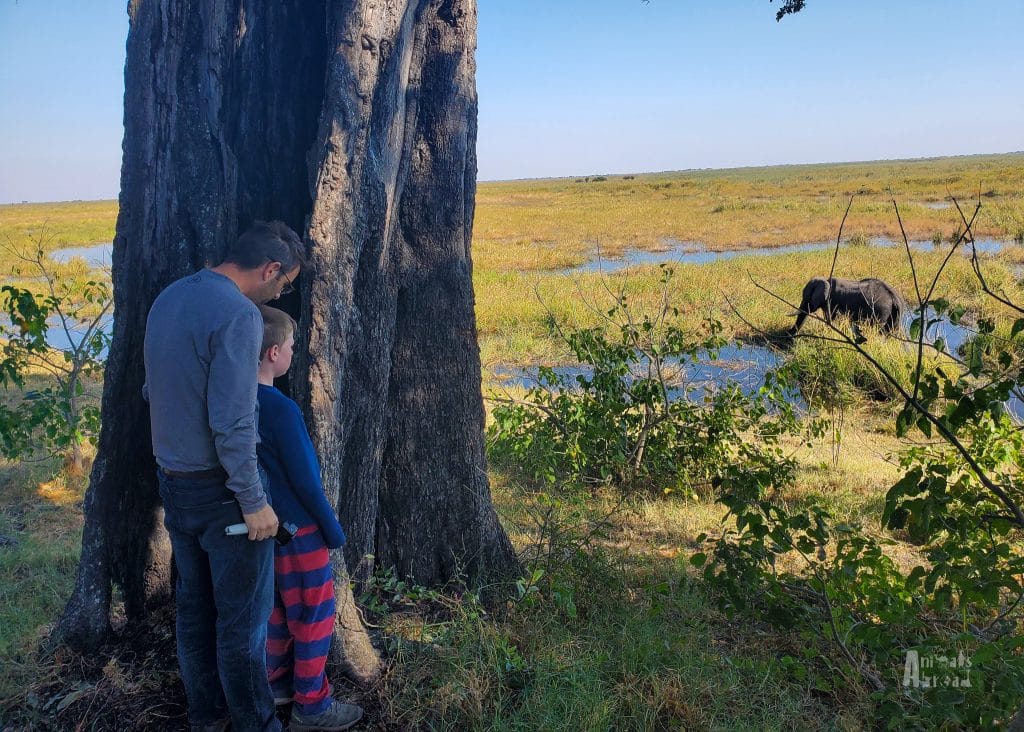
The campsites in Linyanti overlook the vast marshlands where elephants frequently visit to graze and cool off. For the best wildlife sightings, pull up a camping chair and wait for the animals to come to you.
Driving Time: 5 hours from Kasane to Linyanti, Chobe National Park.
Roads: The roads alternated between deep, soft sand and narrow, heavy bush areas, requiring decreased tire pressure for the sand and 4×4.
Supplies: Stock up in Kasane before heading to Linyanti, as there are no grocery stores within Chobe National Park.
Campground: Linyanti Campground
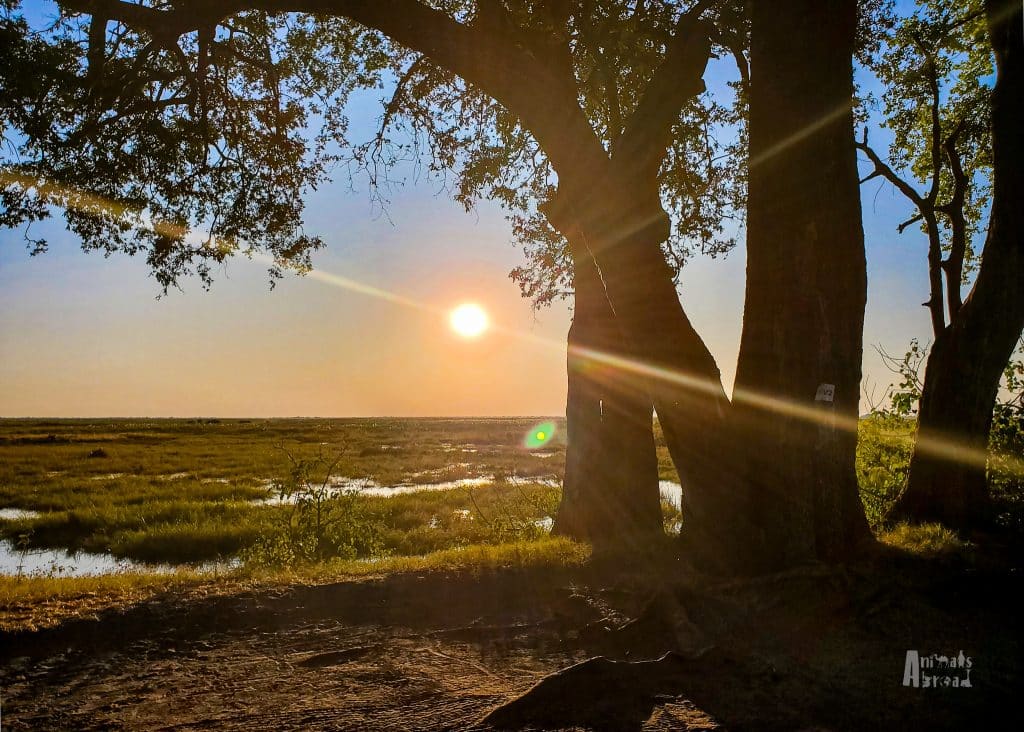
The sites at Linyanti were large and private, surrounded by trees, with views over the floodplains. It felt like we were the only campers there. Water was available on-site, but there was no power. The ablution facilities were clean, although hot water for showers was inconsistent—there was no hot water during our three-day stay. There was no Wi-Fi, restaurant, lodge facilities, or guided game drive.
Safety Tip: Baboons are common in the area. When you leave camp, ensure you put your tent down and leave nothing outside. Lions are known to enter the campground at night—we saw many paw prints around our truck in the morning. Avoid walking to the ablution stations after dark. Elephants roam the camp at all hours—some can be aggressive, as poaching is still a concern in this area.
Day 37 & 38: Savuti, Chobe National Park
Today was Derek’s 40th birthday, and Chobe National Park didn’t disappoint! Shortly after breakfast, the elephants returned for our viewing pleasure. We spent some time watching them before heading out on our drive to Savuti.
The Savuti area is vast, with various terrains, from forested areas to open grassy savannahs with waterholes. Several trails take you close enough to observe and photograph the game. Over the two days, we saw cape buffalo, giraffes, and wildebeests and were treated to an incredible leopard sighting.
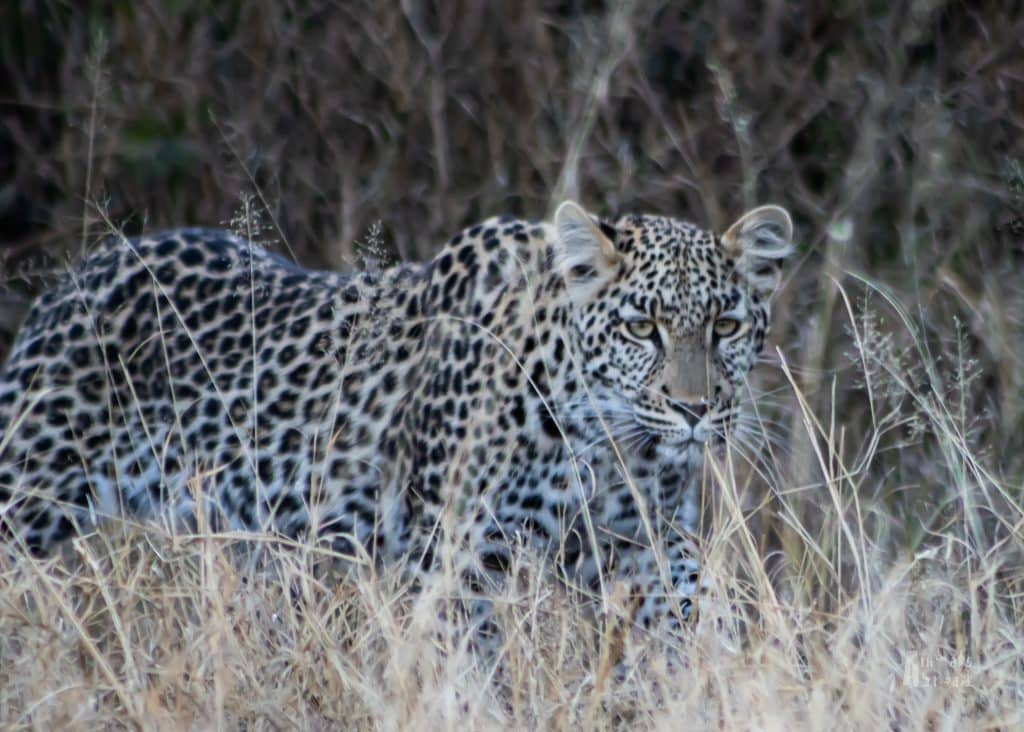
Back at the campsite, a mishap led to an unforgettable evening. While cooking dinner over the fire pit, Derek burned himself. His painful screams alerted a neighbouring camper, who came over to check on us. While chatting, we shared that it was Derek’s birthday. No sooner had we finished dinner than our neighbour returned with his friend and a bottle of champagne. We spent the rest of the evening enjoying the bubbly and swapping safari stories. They shared an amazing recent sighting of a pride of lions taking down an elephant on their way to Khwai, our next destination.
Driving Time: 2 hours and 30 minutes from Linyanti to Savuti (with stops for game viewing).
Roads: Moderate to deep soft sand with compact areas. Reduced tire pressure for the sand, and a 4×4 was required.
Campground: Savuti Campground
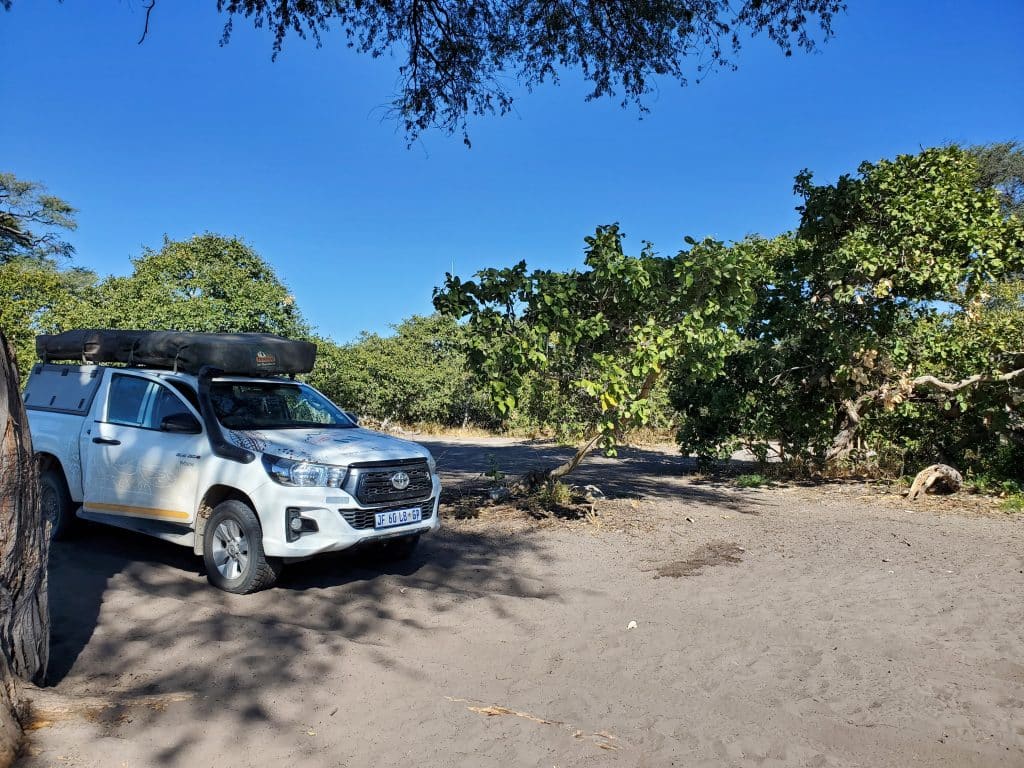
The Savuti campsites were large and shaded by trees but close together, with limited privacy. Water was available on-site, but there was no power. The deep sand on the sites made setting up our tent ladder tricky, and it felt like we were camping on a beach. The ablution facilities were clean, with multiple showers and toilets. Hot water was available, though intermittent. Laundry services and wash sinks were available for self-laundry. A restaurant and lodges were on-site, and Wi-Fi was available at reception.
Safety Tip: Unlike in Namibia, Botswana’s campsites are open, meaning animals roam freely. If your campsite is far from the ablution station, avoid walking at night, due to the possibility of game, including large cats, nearby. One evening, around dinner when the campground was still lively, Derek and Mason spotted a leopard crouching in the bushes about 15 meters away, while walking to the bathroom. We later learned that the same leopard had passed through a neighbouring campsite just moments earlier.
Day 39: Savuti to Khwai, Moremi Game Reserve
With directions from our neighbours to the lion kill, we set off to Khwai. Little did we know the adventure we were in for. What was supposed to be a 5-hour drive from Chobe to Moremi Game Reserve turned into an 11-hour journey filled with both excitement and danger. It was a day we would describe as the best and worst of our safari experience, all wrapped up in one.
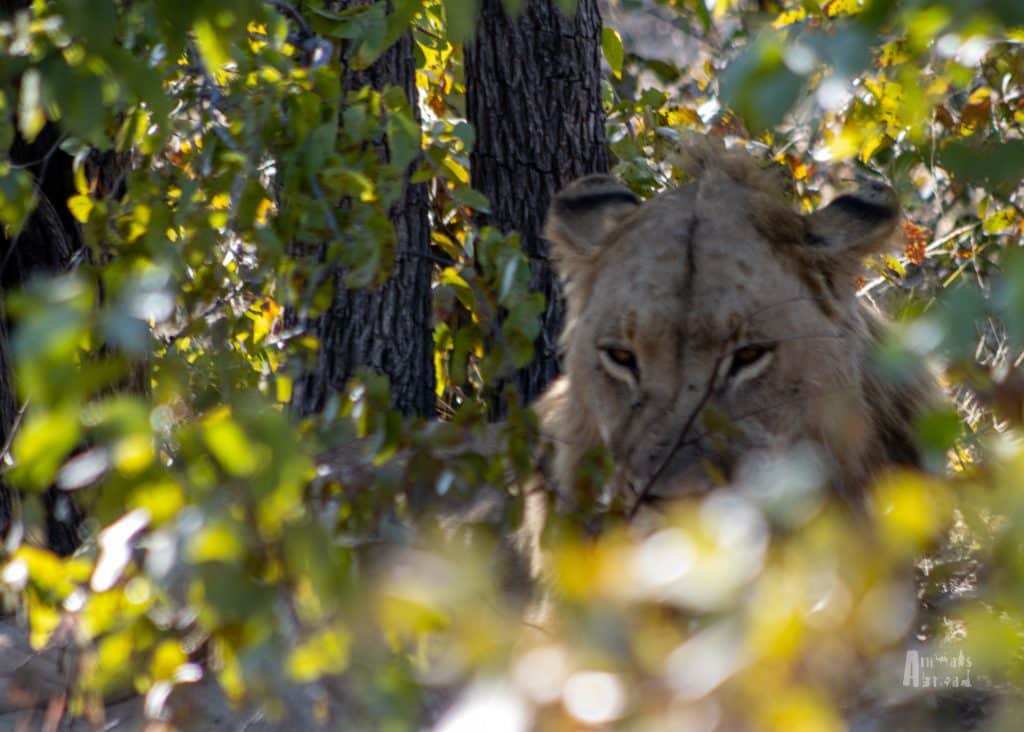
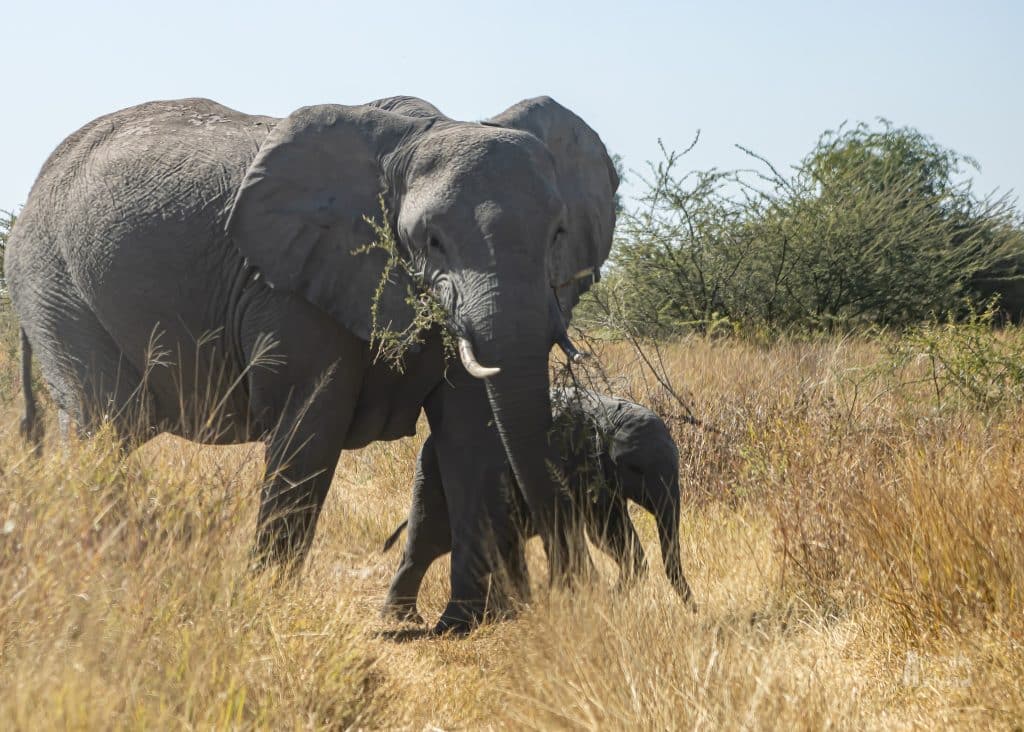
Driving Time: 5 hours according to GPS, but allow extra time for game viewing.
Road Tip: When leaving Chobe NP, take the Marsh Road instead of the Main Road. The Main Road is known for its deep sand and is challenging to navigate, with fewer opportunities for game sightings. The Marsh Road is a mix of compact dirt and moderate soft sand; 4×4 is required in certain areas.
Campground: Khwai Campground
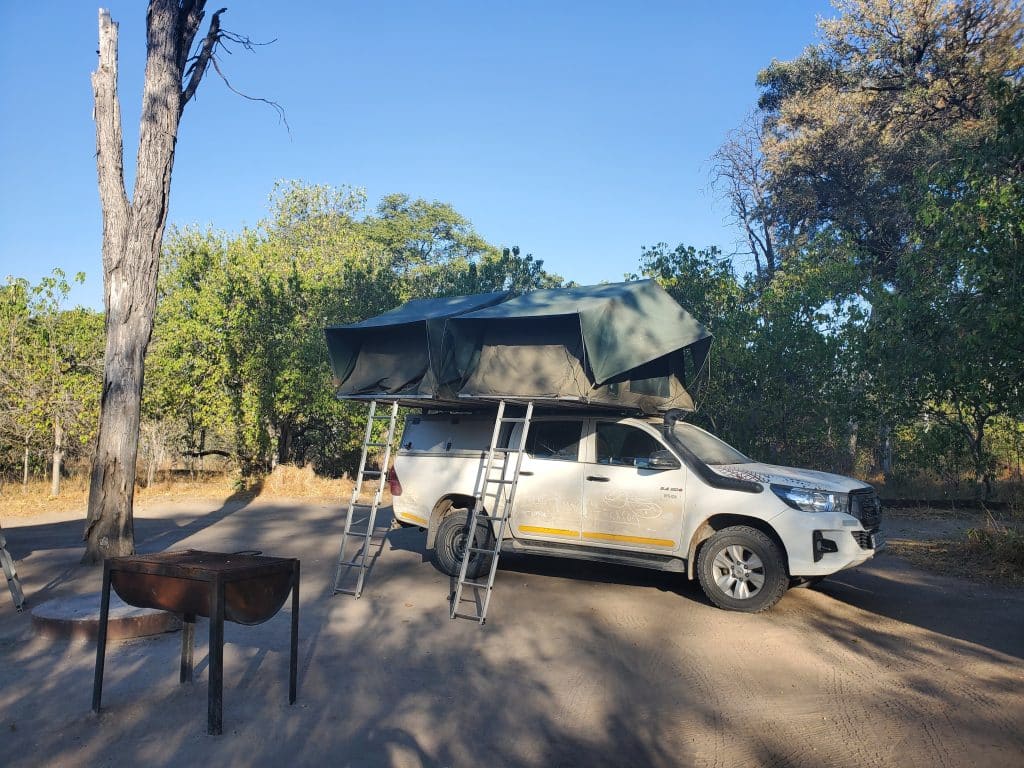
The Khwai campsites, like those at Linyanti and Savuti, are part of the same chain (SLK), though Khwai is in a different park. The campsites were well-spaced, shaded with trees, and offered plenty of privacy. Water was available onsite, but there was no power. The ablution facilities were clean, with multiple showers and toilets. Hot water was available intermittently. No lodges or restaurants, and no Wi-Fi, or guided game drives available.
Safety Tips: Be cautious of curious monkeys that will surround the campsites when food is out and will attempt to steal anything they can. Driving to the ablution stations after dark was recommended, no matter how close your campsite is to the facility, as lions prowl the campground at night. We did not see any lions; however, one night, just as we were about to get out of the truck to get ready for bed, we turned on the headlights to find a large spotted hyena lurking in front of us. It quickly vanished into the brush when the lights came on.
Day 40: Khwai, Moremi Game Reserve
Moremi Game Reserve offers the chance to see some of Botswana’s most endangered species, including wild dogs and both white and black rhinos. Located south of Chobe National Park and within the Okavango Delta, Moremi’s beautifully diverse landscape features grasslands, forests, floodplains, and lagoons. Unlike national parks, Moremi is designated as a game reserve and is home to the BaSarwa people.
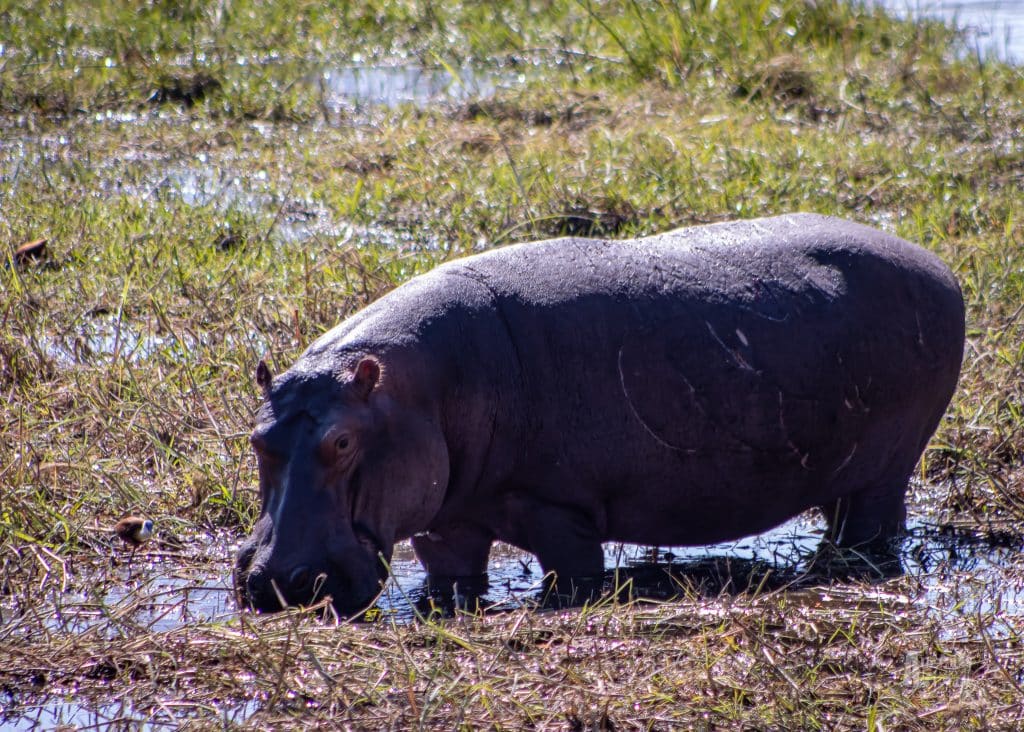
One of our favourite spots in the reserve was Hippo Pond, located near the Khwai campground. This large pond, which resembled a small lake, sat in the middle of expansive grasslands. From the lookout structure, you can see dozens of hippos bobbing up and down in the water, showing off their little ears and large snouts.
Day 41: Khwai to Mankwe Bush Camp (Just outside of Moremi Game Reserve)
Mankwe Bush Camp is where luxury cabins and basic campsites meet, offering the best of both worlds. Upon arriving at the reception, you’ll feel like you’ve stepped into an oasis. Rustic wooden bridges guide you through the resort, leading to two pool decks with padded lounge chairs, personal towels, covered sitting areas, bars, a restaurant, and a reading room. A small watering hole next to one of the pools provided an opportunity to watch wildlife while lounging in the sun.
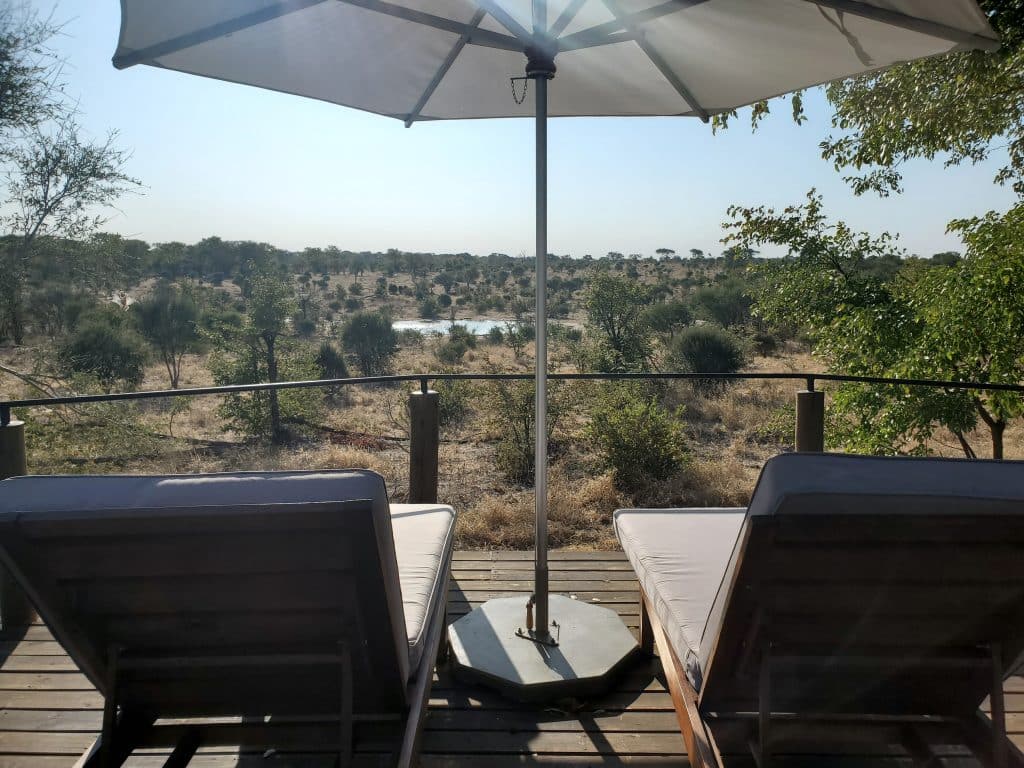
But, just a five-minute drive down the road, you’re in complete wilderness, with only basic camping amenities. The campsites are widely spaced, creating a sense of solitude and immersion in nature.
After setting up camp, we decided to take a break by the pool. The drive here had been stressful, with blocked roads and unreliable GPS directions, which led to Derek chopping down a small bush in the forest to clear the way.
Driving Time: 2 hours and 30 minutes
Roads: The main road outside Moremi was a mix of compact dirt, large potholes, and deep, soft sand. As we approached Mankwe Bush Camp, the terrain changed to narrow paths and uneven, forested areas. 4×4 was necessary in some sections.
Campground: Mankwe Bush Camp
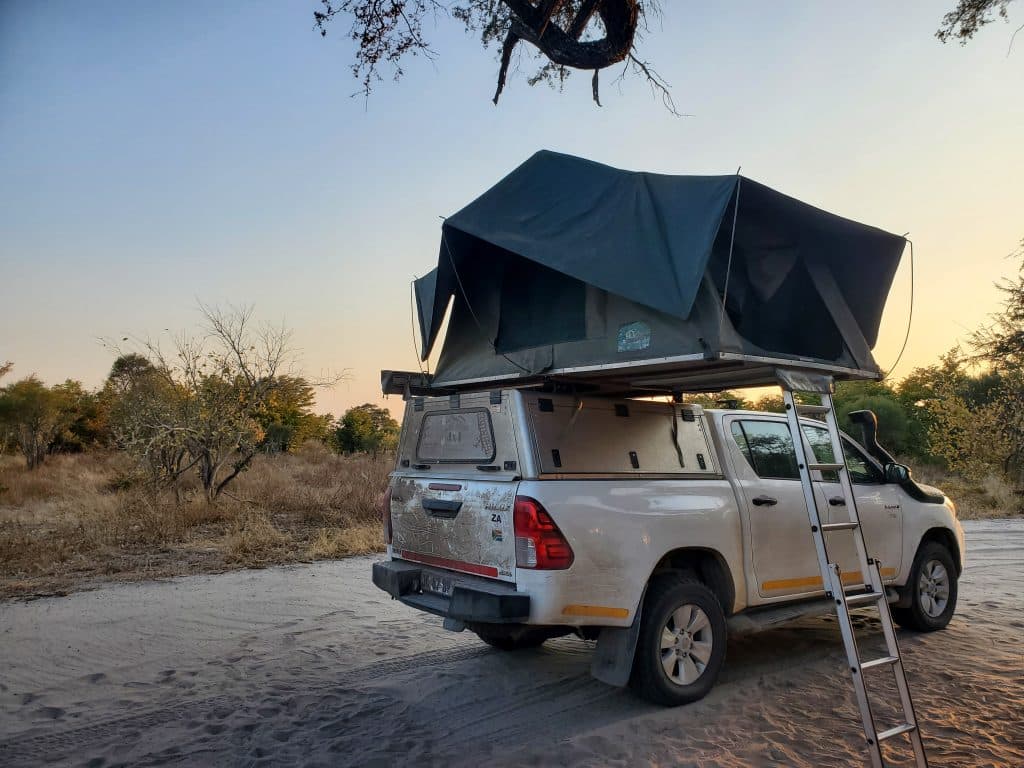
The Mankwe Bush camping area is situated in the middle of a grassy savannah. Each site had a private tented ablution facility with a bag system shower. To use it, you boil water and mix it with cold water to achieve the desired temperature, then open a lever to allow the water to flow. Fresh water isn’t available on-site—only saltwater—so you must bring your own drinking and cooking water. There is no power, but the reception offers a restaurant and Wi-Fi. The resort is not inside Moremi Game Reserve, so there are no additional park fees.
Day 42: Camp Day Mankwe Resort
We woke up to strong winds, reminiscent of the fierce gusts we encountered at Okonjima Reserve. When that happened in Namibia, all the animals hid in the thick brush to avoid the wind. So, rather than heading out on a game drive, we opted to relax by the pool for the day.
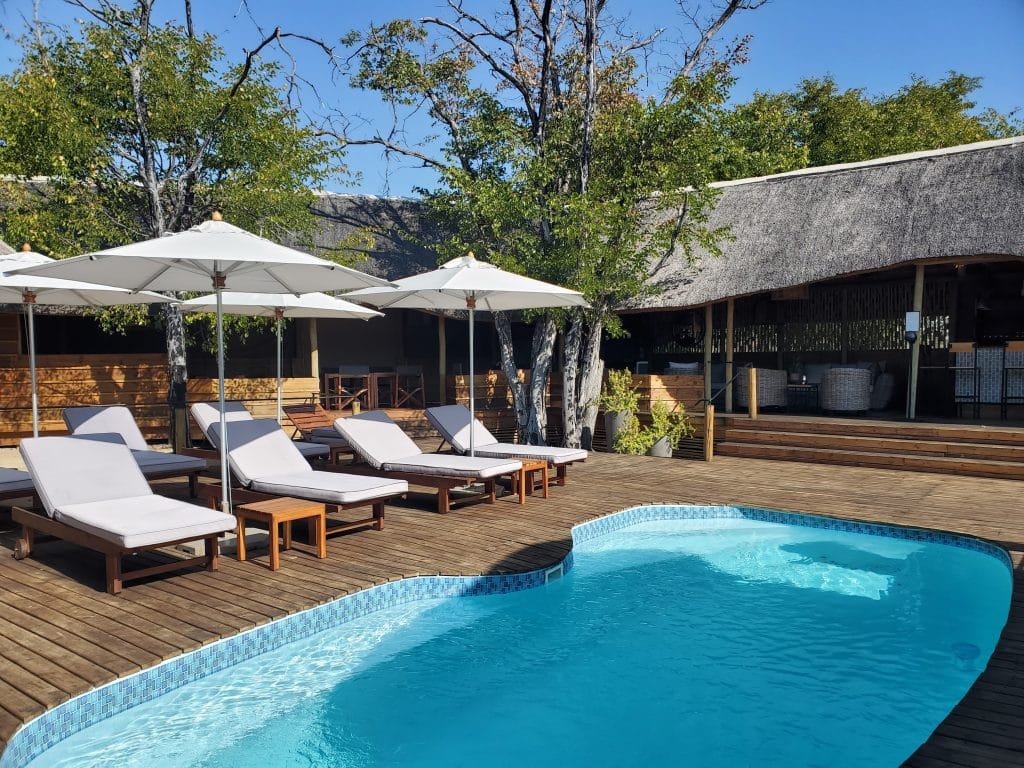
However, luck was on our side when, returning to our campsite in the evening, we saw a leopard swiftly crossing the road before us. Unfortunately, it was too quick for us to capture on camera, but the thrill of seeing it was exhilarating.
Day 43: Mankwe Resort to Maun
After spending eight days deep in the bush, we finally made our way to Maun, a larger city. The afternoon was spent stocking up on supplies and running errands. The Crocodile Camp offered all the amenities we were craving. The boys enjoyed swimming in the pool while I visited the gym. That evening, we treated ourselves to pizza and ice cream at the on-site restaurant.
Driving Time: 2 hours and 30 minutes
Roads: Compact dirt roads with sections of deep potholes for most of the route; the last 30km was paved.
Campground: Crocodile Camp
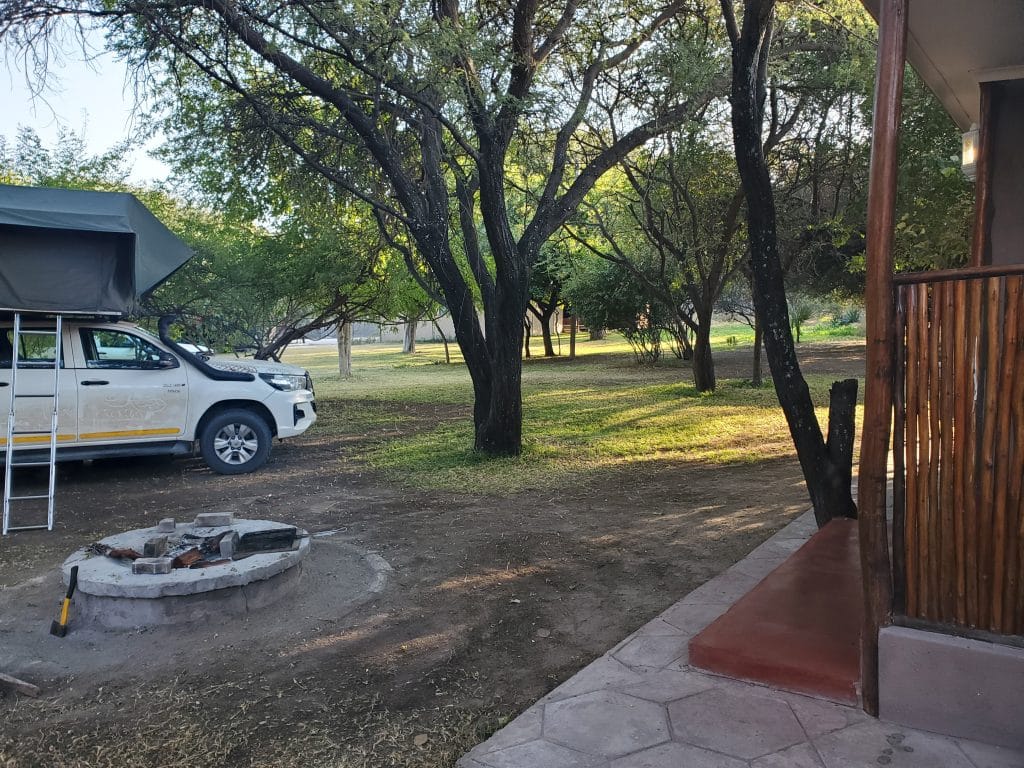
Crocodile Camp is a great option for those seeking creature comforts during their safari. With lodges, a restaurant, two bars, a pool, a spa, and a gym, it was a perfect place to unwind and rejuvenate for a few days. The pool, bar, and restaurant area overlooked a small river where you could watch cows leisurely graze.
Each campsite had private shower and toilet facilities, a covered patio with a washing sink, deep laundry sinks, and a clothesline. While the campsites were very close together, offering little privacy, the amenities made up for it. Water and power were available on-site, with hot water on demand. Wi-Fi reached the campsite. Campers can use all the services, including the restaurant, spa, and gym.
Day 44: Camp Day at Crocodile Camp
Even on safari, we had a few days that felt like home. Derek and I started the morning with a visit to the gym, followed by some laundry, and then enjoyed a hot cup of tea over breakfast. The afternoon was productive—while the boys caught up on schoolwork and had fun in the pool, Derek and I focused on getting some work done. After dinner, Mason and I made Rice Krispies treats and ended the evening by calling our families back home.
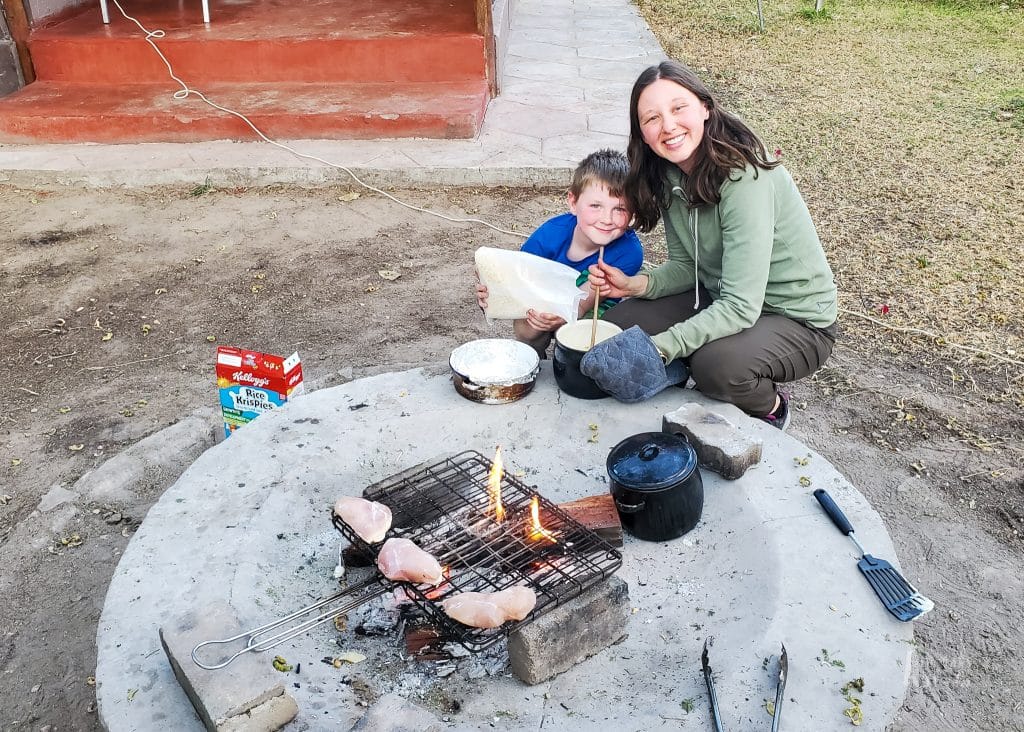
Day 45: Nxai Pan National Park – Baines Baobab
Nxai Pan National Park, located southeast of Chobe National Park and Moremi Game Reserve, was one of our most stunning areas. The Makgadikgadi Pans are a vast collection of salt flats rivalled only by Bolivia’s famous Uyuni Salt Flats. With ancient Baines Baobab trees and incredible landscapes, Nxai Pan National Park will surely create lasting memories.
Learn More: Living Giants, Nxai Pan National Park—a Photo Journey.
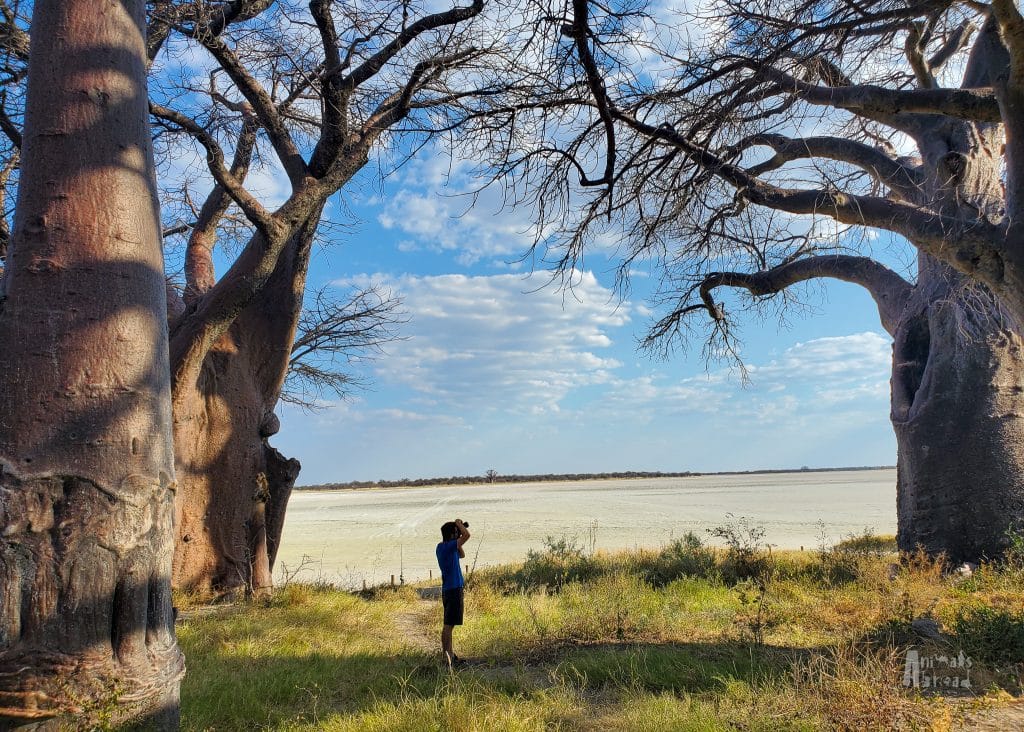
Driving Time: 3 hours from Maun to Nxai Pan Baines Baobab
Roads: Paved roads out of Maun, then compact dirt roads full of potholes and uneven terrain.
Supplies: Be sure to stock up in Maun before entering Nxai Pan National Park. There are no supplies available within the park.
Campground: Nxai Pan Baines Baobab
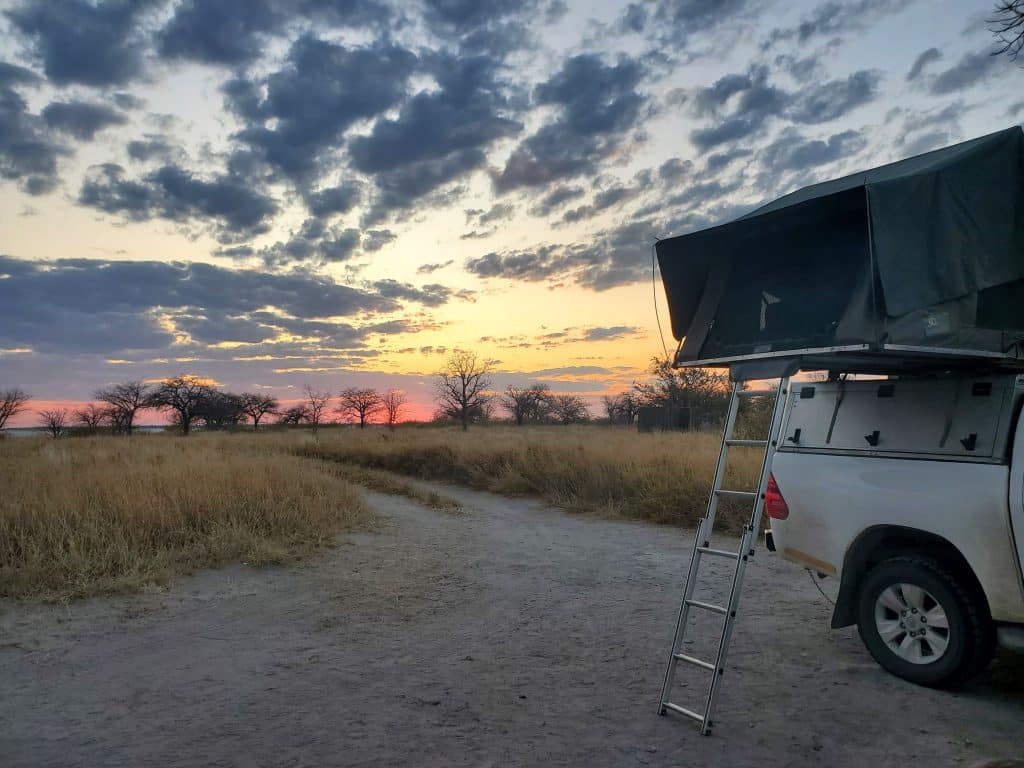
Nxai Pan Baines Baobab Campground was one of the most beautiful campsites we stayed at. However, it was basic and equipped with an outhouse, an outdoor bucket shower, and a single fire pit. There was no power, lights, running water, garbage pick-up, or Wi-Fi.
Day 46: Nxai Pan National Park – South Gate
The South Gate entrance to Nxai Pan National Park offers a remarkable wildlife experience and is known for its active waterholes, attracting a wide variety of species throughout the year, including large herds of elephants, giraffes and, if you’re lucky, lions.
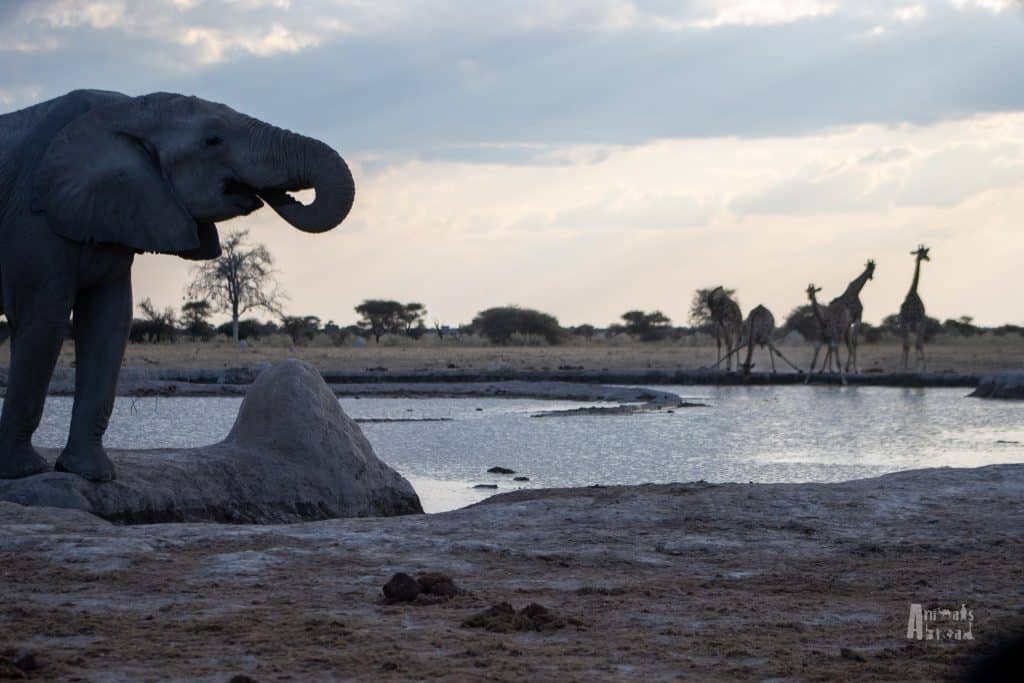
Driving Time: 2 hours.
Roads: Compact dirt roads full of potholes and uneven terrain.
Campground: South Gate
This campground had limited privacy and no power, lights, or running water. However, there are nearby ablution facilities with toilets, hot water for showers, and large sinks for dishes. There was no Wi-Fi. The upside of staying at South Gate was the animal sightings. When we arrived, we were greeted by three elephants grazing next to the ablution facility. We spent over an hour watching them before one casually wandered through our campsite to another grassy area.
Day 47: South Gate Nxai Pan National Park to Elephant Sands Campground
Elephant Sands is famous for its incredible waterhole, which is located next to the campground. Throughout the day and night, families of elephants trudge back and forth to drink and cool off. If you’re fortunate enough to snag one of the campsites up front, you can set up your camp chairs and enjoy the show without moving.
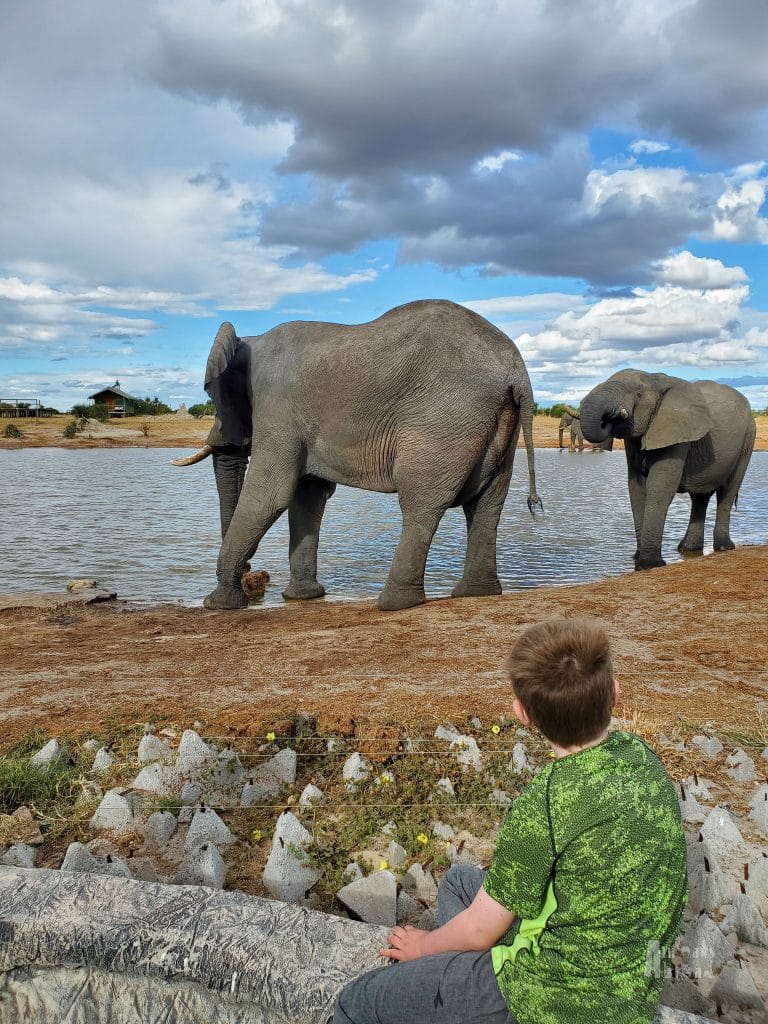
Driving Time: 4 hours and 30 minutes
Roads: Deep sand and compact dirt roads full of potholes and uneven terrain until we left Nxai Pan National Park, then paved road for the rest. 4×4 was required in the park.
Campground: Elephant Sands.
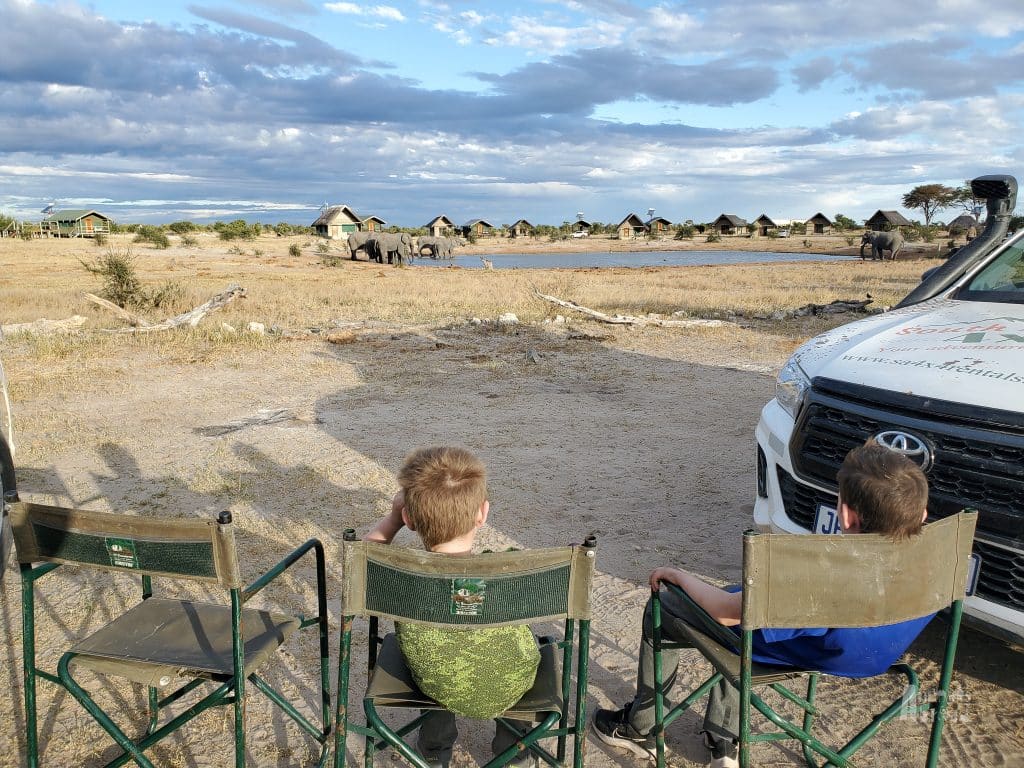
The campground at Elephant Sands was a large grassy field without clearly defined boundaries between campsites. It operated on a first-come, first-served basis. As a result, people often competed for the five campsites closest to the waterhole and squeezed into tight spaces to secure the best views. On our second night there, the campground was so busy it felt like a music festival, with crowds of campers everywhere. Don’t worry if you don’t get a prime spot. The restaurant area has an incredible viewing platform where you can still enjoy the wildlife sightings. The campsites had no water, power, or lights, and the ablution facilities were shared. Wi-Fi was available in the reception/restaurant area.
Day 48: Elephant Sands
We had another birthday celebration today, with Mason turning 9 years old. We spent the day watching dozens of these beautiful giants make their way to and from the watering hole, leisurely sipping as they mingled and socialized with each other. In between sightings, we played board games, pet the owner’s mongooses, and indulged in some birthday cake.
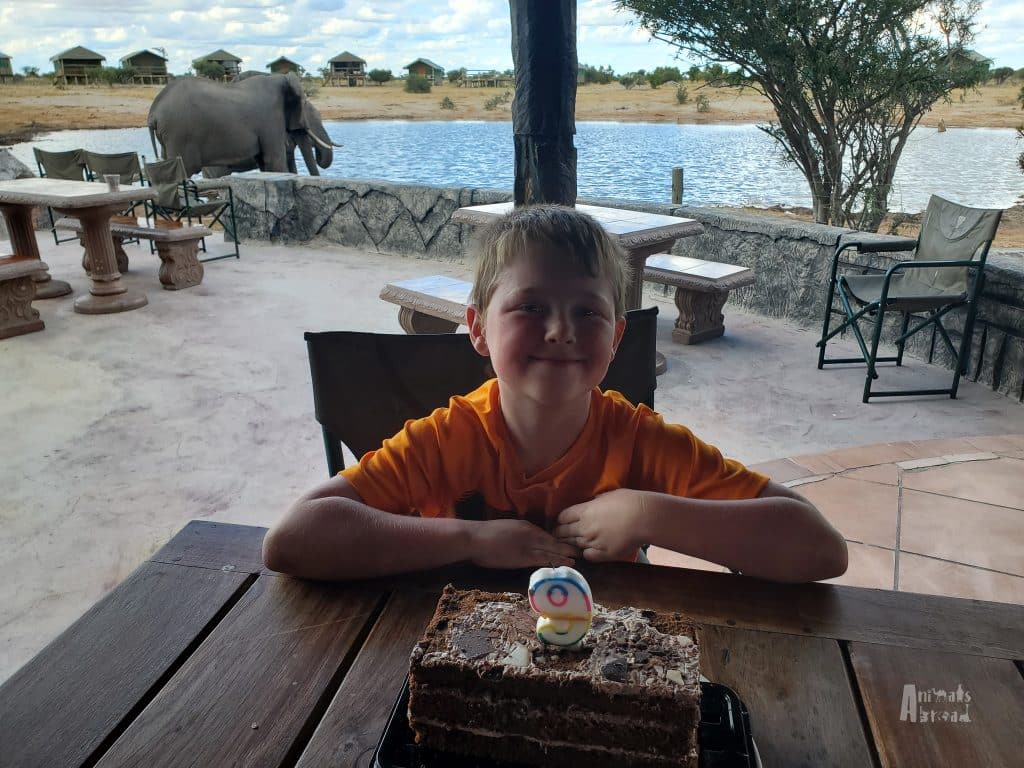
Day 49: Elephant Sands to Limpopo River Lodge
We set off early this morning for the long drive to Limpopo River Lodge. The highlight of the day was a surprise sighting of wild dogs just outside the Elephant Sands campground. A small group was walking near the road, reminding us to always be on the lookout for wildlife.
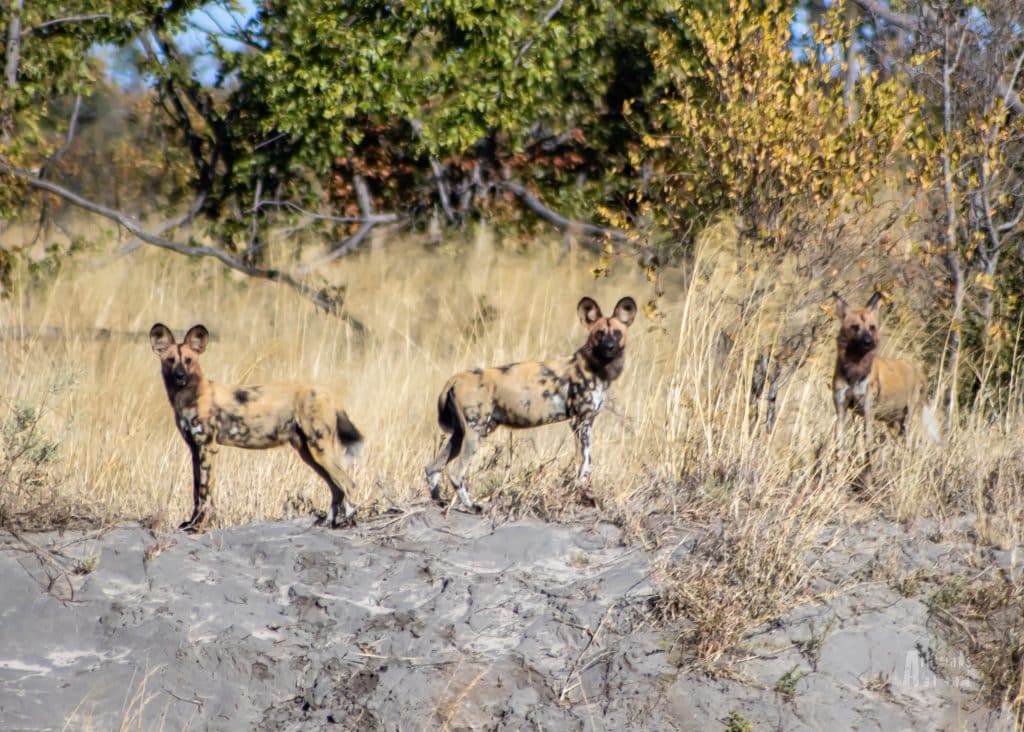
Driving Time: 7 hours and 30 minutes
Roads: Excellent road conditions for most of the drive, with two-lane paved highways and guardrails. The last 30km was off-road with large potholes and rough, uneven terrain. This portion took one hour to drive.
Campground: Limpopo River Lodge.
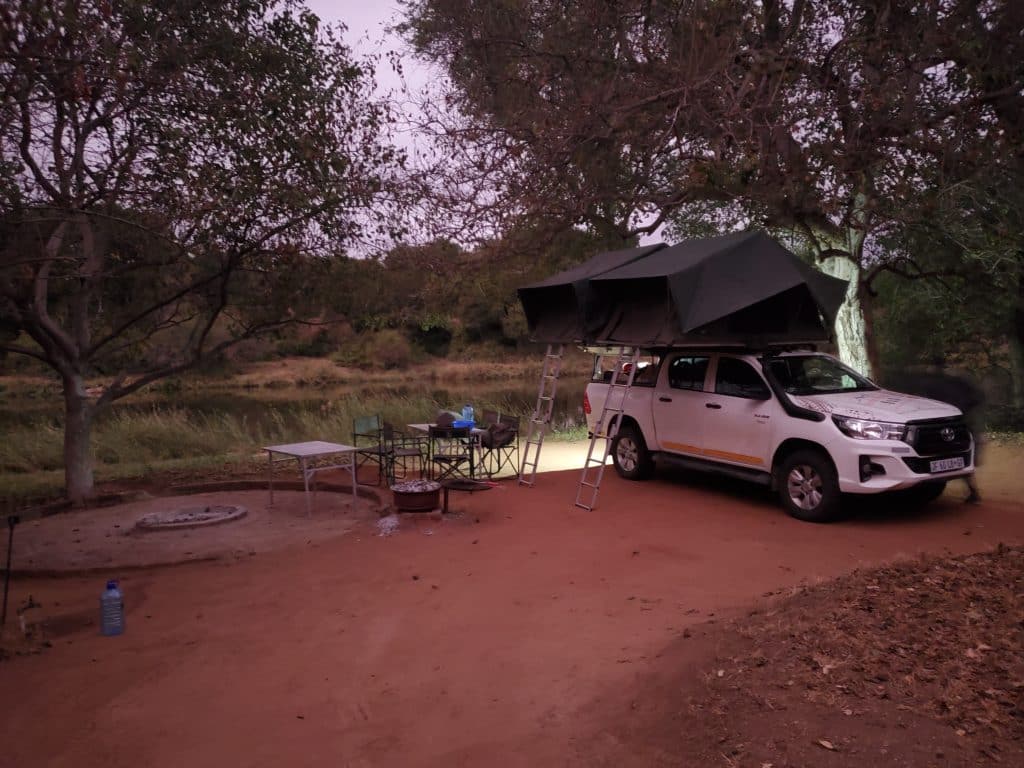
Limpopo River Lodge was a surprise, leaving us wishing we had more time to enjoy this serene campground. Large green trees provided ample shade and privacy, and the sound of the rushing river made for peaceful nights. Private bathrooms and showers with hot water were available nearby, and the river provided water for washing and cooking. Wi-Fi was intermittent at the campsite.
Safety Tip: Be cautious at night and early morning as hippos come out of the water to graze.
Day 50: Limpopo River Lodge to Klein Kariba Resort
Today was another driving day, with our final border crossing. We left early and stopped at Klein Kariba Resort to break up the long journey from Limpopo to Johannesburg.
Driving Time: 5 hours and 30 minutes (not including the border crossing)
Roads: The initial drive out of the campsite was difficult, following the rough, uneven terrain we drove on the previous day to enter the Limpopo campsite. Once through the South African border, the roads were excellent, with paved highways.
Campground: Klein Kariba Resort.
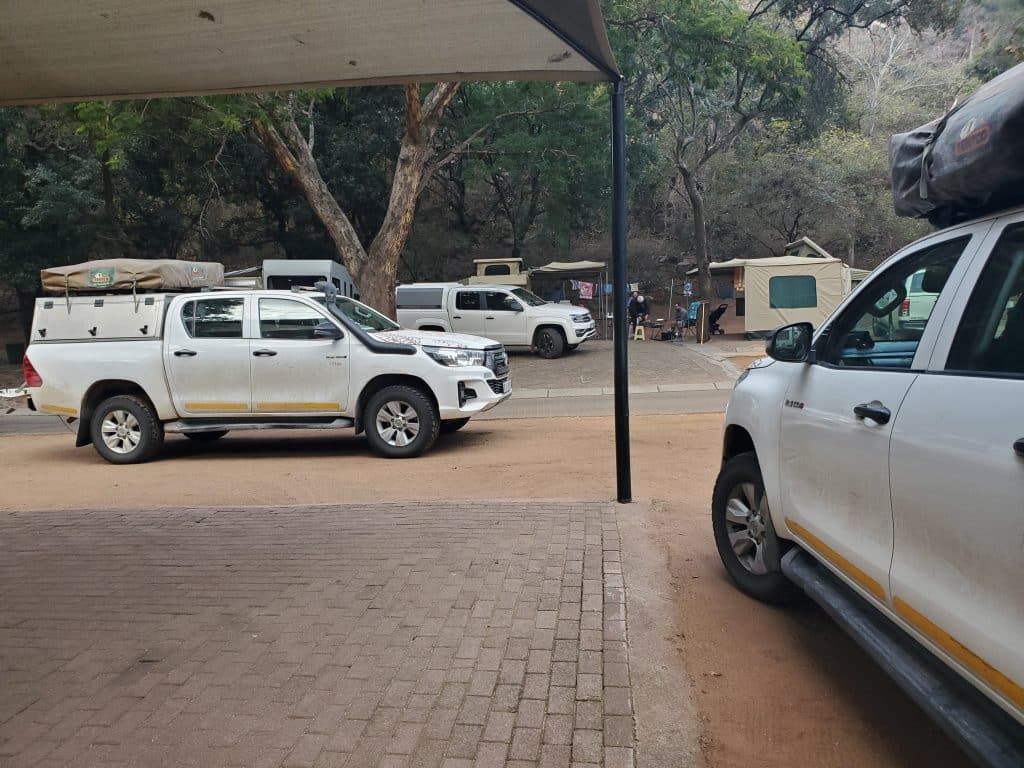
Klein Kariba Resort was indeed a resort! The enormous complex offered multiple accommodations, from camping to fully equipped cabins with TVs, kitchens, and bathrooms. There were several pools, including heated ones, waterslides, and playgrounds. Activities included horseback riding, golf, paddle boats, and an arcade. The ablution facilities were spacious, with showers and bathtubs available. There was a large restaurant, and Wi-Fi reached the campsites.
Each campsite had a tent for sun and rain protection; however, the sites were small and packed closely together. The campsite felt crowded, and the noise and lights persisted late into the evening. This is not a site I would recommend if you’re looking for a tranquil, nature-focused experience. It’s better suited for those seeking comfort and amenities, but it was far too busy for our liking.
Day 51: Klein Kariba Resort to Johannesburg Airport
Drive Time: 2 hours on paved highway.
Our last safari day was spent packing up and heading to Johannesburg Airport. It was a bittersweet moment as we marked the end of an incredible chapter in our world trip.
As we wrapped up our journey, one thing was clear: the memories we made will last a lifetime, and we wouldn’t trade a single moment. Our time in the wilds of Africa—camping under the stars, encountering wildlife up close, and embracing the challenge of the road—left a permanent mark on our hearts.
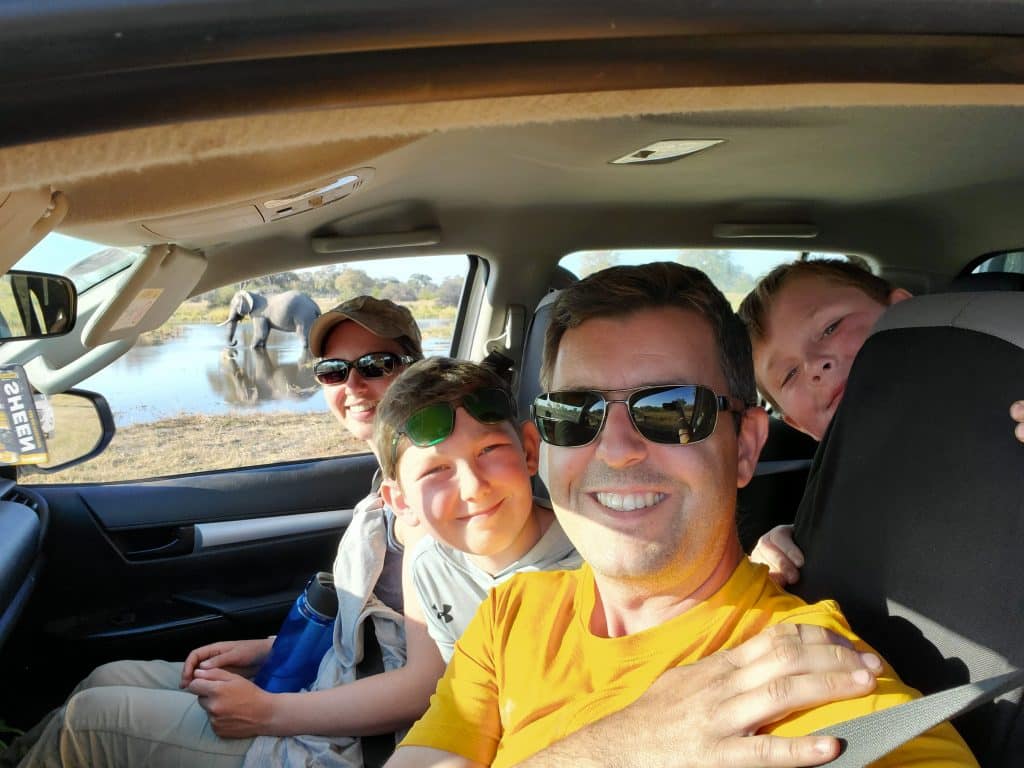
Despite spending 51 days camping, we weren’t quite ready to leave, wishing we had more time to explore the beauty Africa has to offer. This adventure showed us that stepping out of our comfort zones opens the door to some of life’s most unforgettable experiences. and brought us closer as a family. I have no doubt that we will return someday to relive the magic of it all.
Ready to Start Planning Your Safari Adventure?
Check out these related posts to help plan your trip:
- 51-Day Africa Safari – Part 2: Namibia’s Etosha & Caprivi Strip
- 51-Day Africa Safari – Part 3: Victoria Falls & Botswana
- Our Best and Worst Day on Safari
- Camping Safari in Africa: Know Before You Go
- Camping Across Southern Africa: A Rundown of our Safari Campsites
- Navigating Border Crossings in Southern Africa
- Safari with Kids: Tips from the Road
- Etosha NP with Kids: A Family Safari to Remember
- Exploring the Caprivi Strip with Kids
- Okonjima Family Safari: Where the Wild Things Wait
- The Smoke that Thunders: A Trip to Victoria Falls
- Into the Wild: Chobe NP with Kids
- Sunset Cruise on the Chobe River: A Photo Journey
- Living Giants: A Photo Journey Through Nxai Pan National Park
